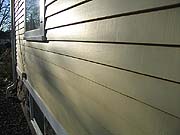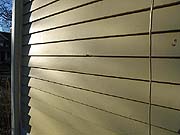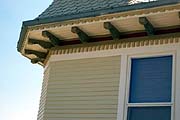 |
 |
 |
 |
 |
|
Click to Enlarge Images Below
|
 |
 |
Stripping an entire house is indeed possible with The Silent
Paint Remover. The Silent Paint Remover™ was used
to in the complete paint removal of this 2600 square foot American
four square built in 1912. We estimated the house to have had about
8 to 15 coats of paint. Several layers of paint were lead based
as you can anticipate on a house of this vintage.
The Silent Paint Remover™ handled this job easily. This project
created a lot of curious people wanting to know how the paint was
being removed. We sure are happy with the end result. We anticipate
this paint-job to last for 20 years. This is likely how long the
first paint job applied 1912 lasted. No other paint removing method
would have come close this quality end result.


|
|
|
 |
 |
 |
Before Paint is Removed This is common paint failure due
to inadequate preparation of the wood surface. Paint needs to be
removed completely. .
|
|
|
 |
 |
 |
Starting Out First we covered the ground with thick plastic
sheets to avoid dropping lead-contaminated paint chips into the
ground. Then painter, John Brady, started by removing the storm
windows, installing the track for the hand-free attachment and then
he was off removing paint with limited work interruption. Heating
time was approximately 20 to 30 seconds on each area of 12” by 5”.
|
|
|
 |
 |
 |
The Hands-Free Attachment In this photo you can see how
the painter, John Brady, is using the hands-free attachment wall
attachment. Mounted as close as possible to the soffit. He is working
horizontally. It took John 5 days to remove all layers of paint
on each side of this house, including the windows. John works by
himself.
|
|
|
 |
 |
 |
Here you can see the hands-free up close. The tool is shut of right
here while we took the photo. You need to pay attention and not
leave the tool unattended. The tool can be swiveled 360 degrees.
In this position you can finish scraping the paint if you can not
keep up with the tool. Sometimes you can scrape paint off at the
same speed the tool can heat the paint. The paint will stay warm
for approximately one minute in the summer. This is enough time
to scrape the paint completely off.
|
|
|
 |
 |
 |
The Complete Process This photo shows the paint removing
process in all three stages: before, scraped, and primed. The old
yellow paint is on the left side. The painter is applying the first
coat of linseed oil primer the same day the paint was removed, reducing
exposing the wall to rain & moisture.
Primer Purified boiled linseed oil primer. We applied 2
coats. First coat of primer went on right after the paint was removed.
Leaving the bare wood is not recommended. Bare wood will absorb
moisture like a sponge. The absolute best time to apply the primer
is right after the paint has been removed.
Top Coat Use Pure Organic
Linseed Oil paint. Only pure Organic Linseed Oil paint stands
the test of time. It does not crack, peel, fade and it will never
trap moisture that will cause the wood to rot. Organic
Linseed Oil Paint is very easy to maintain by simply applying
the organic boiled linseed oil onto the dry and aged surface every
5-10 years. We do not recommend any fancy mixture that the painting
industry has recently invented.
No Sanding was Required No power sanding was used on any
aspects of this paint job. Power sanders are counter productive
when it comes to preparing surfaces for painting. Traces of paint
will always remain on the surface. Using a power sander will heat
the paint residue pushing it into the wood and closing the grain.
This will prevent the paint from achieving a good tooth. A light
hand sanding was done before and after priming. We did several tests
prior to this projects demonstrating that you do not have to sand
at all to get a great, long-lasting paint surface.
|
|
|
 |
 |
 |
 Steady
Progress Almost finished two sides of the house. This method
will remove the paint down to the surface regardless of how many
layers of paint you have. Removing the paint off this house was
relatively easy. The paint still had a fair amount of oil in it
and reacted very well to the heat. A very small amount of dust was
created during the scraping. The process was completely silent. Steady
Progress Almost finished two sides of the house. This method
will remove the paint down to the surface regardless of how many
layers of paint you have. Removing the paint off this house was
relatively easy. The paint still had a fair amount of oil in it
and reacted very well to the heat. A very small amount of dust was
created during the scraping. The process was completely silent.
|
|
|


|
 |
 |
 Use
Your Imagination Once again the innovative Bob Workman has come
up with another great idea! Here is a photo of a homemade rig that
worked well on the ceilings. A vacuum canister on rollers, 5 gallon
paint can lid with a hole in it, some sand, and an adjustable pole
from a concrete float. They did two porch ceilings with it in no
time at all. Use
Your Imagination Once again the innovative Bob Workman has come
up with another great idea! Here is a photo of a homemade rig that
worked well on the ceilings. A vacuum canister on rollers, 5 gallon
paint can lid with a hole in it, some sand, and an adjustable pole
from a concrete float. They did two porch ceilings with it in no
time at all.
|
|
|
 |
 |
 |
Hard-to-Reach Areas This fantastic job done by Bob & Carol
Workman shows that you can use The Silent Paint Remover™ in
those "Hard To Reach" areas. The trick is to add to the heating
time, not putting the tool too close to the surface. Also, using
a quality scraper like the type you find on our accessories scraper
page is a big help.
|
|
|
 |
 |
 |
Easy, Safe Lead Paint Clean-Up With The Silent Paint Remover™
System, you can collect most of the paint waste – making this the
most environmentally friendly paint removing system available today.
John removed approximately 70 lbs. of dry paint on each wall – a
total of 275 lbs. removed. The house had at least eight coats of
lead-based paint. With other methods like grinding and sanding,
you would only be able to collect a very small amount of the paint
dust if any at all.
|
|
|
 |
 |
 |
What we like most about the SPR method.
- You can paint right after the paint or varnish is removed.
- Longevity of the paint job. The surface preparation will make
the paint stay on for at least 20 years.
- Environmental friendliness. The paint chip waste is dry and
can be disposed as household waste by the homeowner in all 50
states.
- Reduction in “painter burnout”. The SPR system is easy and
satisfying for painters to work with. Minimal exposure to dust
and sound pollution was a welcomed relief (for the painter as
well as the whole neighborhood) when compared to other methods.
|
|
|
|
 |
| |
|
|










